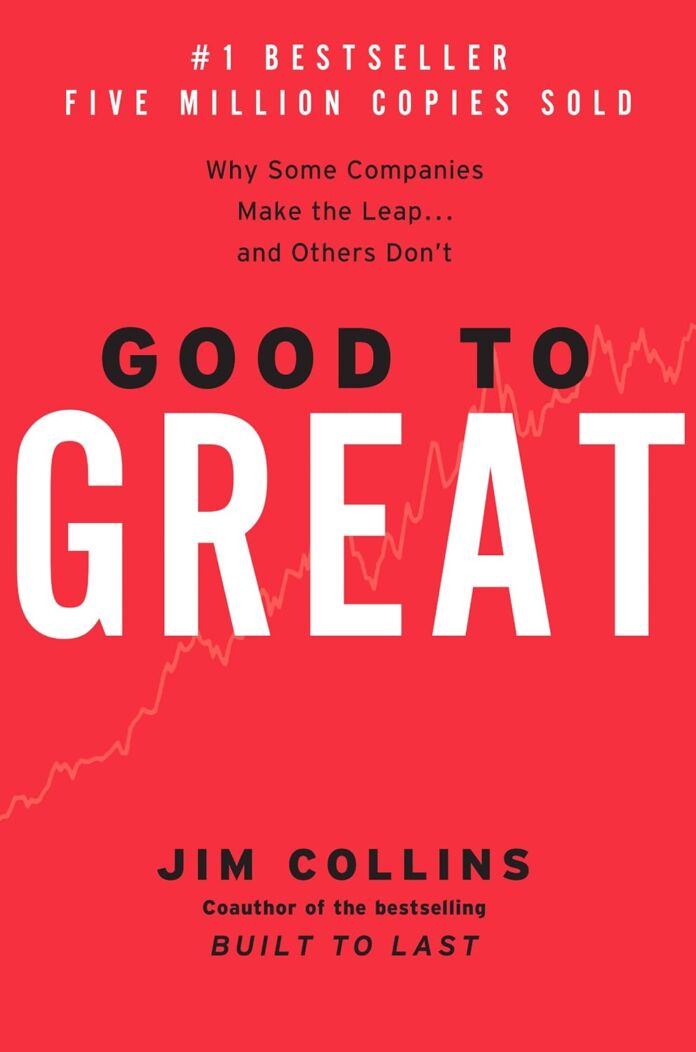Title: Good to Great
Author: James C. Collins
Publisher: Harper Business
Genre: Business, Strategy
First Publication: 2001
Language: English
Book Summary: Good to Great by James C. Collins
To find the keys to greatness, Collins’s 21-person research team read and coded 6,000 articles, generated more than 2,000 pages of interview transcripts, and created 384 megabytes of computer data in a five-year project. The findings will surprise many readers and, quite frankly, upset others.
The Challenge
Built to Last, the defining management study of the nineties, showed how great companies triumph over time and how long-term sustained performance can be engineered into the DNA of an enterprise from the very beginning.
But what about the company that is not born with great DNA? How can good companies, mediocre companies, and even bad companies achieve enduring greatness?
The Study
For years, this question preyed on the mind of Jim Collins. Are there companies that defy gravity and convert long-term mediocrity, or worse, into long-term superiority? And if so, what are the universal distinguishing characteristics that cause a company to go from good to great?
The Standards
Using tough benchmarks, Collins and his research team identified a set of elite companies that made the leap to great results and sustained those results for at least fifteen years. How great? After the leap, the good-to-great companies generated cumulative stock returns that beat the general stock market by an average of seven times in fifteen years, better than twice the results delivered by a composite index of the world’s greatest companies, including Coca-Cola, Intel, General Electric, and Merck.
The Comparisons
The research team contrasted the good-to-great companies with a carefully selected set of comparison companies that failed to make the leap from good to great. What was different? Why did one set of companies become truly great performers while the other set remained only good?
The Findings
The findings of the Good to Great study will surprise many readers and shed light on virtually every area of management strategy and practice. The findings include:
Level 5 Leaders: The research team was shocked to discover the type of leadership required to achieve greatness.
The Hedgehog Concept (Simplicity within the Three Circles): To go from good to great requires transcending the curse of competence.
A Culture of Discipline: When you combine a culture of discipline with an ethic of entrepreneurship, you get the magical alchemy of great results. Technology Accelerators: Good-to-great companies think differently about the role of technology.
The Flywheel and the Doom Loop: Those who launch radical change programs and wrenching restructurings will almost certainly fail to make the leap.
Book Review: Good to Great by James C. Collins
Published in 2001, “Good to Great: Why Some Companies Make the Leap…and Others Don’t” by business consultant and author Jim Collins takes an in-depth look at what separates outstanding companies from the merely good. The book is based on a comprehensive 5-year research project examining companies that made the leap from good performance to great results, sustaining that leap for at least 15 years.
Collins and his research team identified 28 companies that transitioned from good to great results and sustained the performance. They compared these companies to a set of comparison companies in the same industries to understand what differentiated the good-to-great companies. The findings detail the key factors, behaviors, and processes required to make the transition from good to truly great.
The book presents insightful concepts like the flywheel effect, the hedgehog concept, and Level 5 leadership. Collins suggests companies need several key ingredients—disciplined people, the right priorities, a culture of excellence, and high-quality leadership—to start and sustain the flywheel towards superior performance. Overall, the book makes a data-driven and compelling case for the attributes shared by companies that achieve enduring greatness.
The Research Project
Collins details the comprehensive research effort undertaken by his 21-person research team. To identify companies that had transitioned from good performance to great results, Collins started with a list of 1,435 established companies and narrowed the list down based on specific criteria.
Eligible companies needed to demonstrate the good-to-great pattern: 15-year cumulative returns at or below market, followed by 15-year returns at least three times the market. Furthermore, the transition point from good to great needed to be obvious. Collins identified 11 good-to-great companies from a diverse mix of industries that met these demanding criteria.
To provide comparisons, the team also selected peer companies in the same industries with similar opportunities and resources. However, these comparison companies failed to make the good-to-great leap. Examining direct comparisons enabled Collins to differentiate luck or industry conditions from the crucial drivers for making the shift.
In total, Collins and his team exhaustively analyzed the performance, leadership, practices, and transitions of 28 companies (11 good-to-great and 17 comparisons). The book shares the key discoveries and learning from 85 interviews with senior executives across the 28 companies during the 5-year research effort.
Key Concepts: Level 5 Leadership, Flywheel, and Hedgehog Concept
Collins introduces several compelling ideas that underpin the transition from good to great. Among the most noteworthy are the concepts of Level 5 leadership, the flywheel effect, and the hedgehog concept.
Level 5 Leaders
One of the most central findings from the research highlights the importance of leadership, specifically what Collins terms as “Level 5 leadership.”. The study found every good-to-great company had Level 5 leadership during pivotal transitions.
These leaders display a powerful mixture of humility and intense professional will. They are ambitious for the company and its success rather than themselves. Additionally, they have the ability to set up their successors and the company for enduring success. Collins contrasts Level 5 leaders with other types, like highly charismatic or celebrity leaders, who often fail to transition an organization to greatness.
The Flywheel Effect
Collins describes the flywheel effect to capture the momentum great companies develop over time. The flywheel depicts the deliberate process where organizations slowly build connections to accelerate performance.
With Level 5 leaders at the helm, great companies bring a methodical approach to understanding capabilities, building the right culture and people, and driving performance. Bit by bit, these interconnected elements combine to propel exceptional results – much like the compounding effects of a flywheel picking up speed.
The Hedgehog Concept
The hedgehog concept refers to great companies’ ability to simplify complex environments into a basic principle guiding their priorities. Collins draws upon the ancient Greek parable – “the hedgehog knows one big thing” – to describe the single-minded focus driving great companies.
Great companies are able to ignore distractions and complexity to operate within their hedgehog concept. Their simplified lens helps them understand what best aligns with their mission and capabilities for driving performance. Maintaining fierce consistency with their hedgehog concept is vital for delivering great results.
Key Findings: People, Priorities, and Performance
At their core, Collins finds great companies have three dimensions firmly in place: the right people, the right priorities, and performance orientation.
Great companies are rigorous, not rigid, on talent. They adhere to disciplined recruiting and consistently let go of people not fulfilling expectations. However, they avoid constraining boundaries, considering great performers regardless of background or experience.
Additionally, great companies remain centered on priorities tied directly to their mission and profit drivers rather than exploring peripheral initiatives. They also enable broad employee participation to reinforce the right drivers.
Finally, great companies build a focused, performance-oriented culture oriented around collaboration and the flywheel effect. They blend relentless expectations with employee development and collective achievement. This forms the cornerstone, allowing disciplined action and alignment to compound over time.
Surprising Results and Key Takeaways
Collins highlights several important conclusions for driving organic company success while dispelling common leadership misconceptions.
First and foremost, Collins found acquiring star executives from high-profile companies was negatively correlated with ascending from good to great. Great companies favored development from within rather than flashy outside hires.
Furthermore, many common leadership approaches failed to stimulate greatness. Driving change through radical, dramatic moves rarely propelled great results. Similarly, Collins found greatness did not stem from visionary, celebrity-status leaders who frequently derail momentum.
Instead, Collins emphasizes the marathon-like process where Level 5 leaders channel collective focus towards long-term goals rather than short-term gains. Sustaining the right people and culture facilitates this. With upfront communication and consistency, change management happens gradually as employees rally around the flywheel’s momentum.
Finally, perhaps Collins’ most important takeaway is that great results stem foremost from conscious choice and discipline. Company leaders choose greatness by implementing sound, deliberate decisions driven by focus – not circumstance. With the right people and the right collective discipline, Collins suggests nearly any organization can propel from good to insanely great results over time.
Criticism
While Collins’s book highlights several poignant conclusions, it leaves some areas open to criticism. Most prominently, several researchers have questioned whether Collins’s key findings can reliably apply across more diverse company types.
The companies examined in the study consisted primarily of conventional consumer brands and industrial firms. Critics argue service firms and technology companies operate under different circumstances that limit the relevance of concepts like the flywheel.
Additionally, some analysis has suggested a company’s greatness may simply stem from establishing dominance through scale early within an industry. Consequently, smaller players may struggle to replicate good-to-great trajectories.
Finally, since Collins’s publishing, companies spotlighted like Circuit City and Fannie Mae have faltered, conflicting with the book’s view of 10X success and sustained trajectories. This arguably limits the universality of the monolithic good-to-great model.
However, supporters counter that Collins examines long-term transitions, not indefinite outcomes. Regardless of latter turmoil, these companies still demonstrated the good-to-great shift and decade-plus greatness initially.
Conclusion
Two decades after its release, “Good to Great” remains widely esteemed as one of the most insightful business leadership books. Collins put together an ambitious, data-driven analysis of what differentiated the most successful, enduring companies.
The book highlighted compelling and counterintuitive insights around talent, leadership, change management, culture, and the focus required to achieve greatness. While elements rightfully warrant skepticism and continued examination, few works provide such an extensively researched and detailed look at the drivers, execution, and disciplines yielding large-scale company success.
For these reasons, both business executives and academic communities continue to study it. While debate remains on some findings, the core concepts help provide a blueprint for organizations aiming to implement cultural identity, practices, and leadership, enabling the ascendance to sustained, superior results leveling companies like Fannie Mae and others never reached or maintained.





